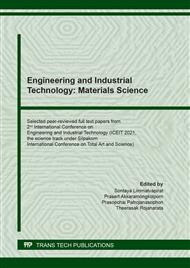[1]
M. N. Masum, K. Yamauchi, T. Mitsunaga, Tyrosinase inhibitors from natural and synthetic sources as skin-lightening agents, Rev Agric Sci. 7 (2019) 41-58.
DOI: 10.7831/ras.7.41
Google Scholar
[2]
T. S. Chang, An updated review of tyrosinase inhibitors, Int J Mol Sci. 10 (2009) 2440-2475.
Google Scholar
[3]
Y. J. Kim, H. Uyama, Tyrosinase inhibitors from natural and synthetic sources: structure, inhibition mechanism and perspective for the future, Cell Mol Life Sci. 62 (2005) 1707-1723.
DOI: 10.1007/s00018-005-5054-y
Google Scholar
[4]
K. Singpanna, A. Oekchuae, K. Jereonkunmetee, A. Athipornchai, N. Nuntharatanapong, P. Opanasopit, et al., Synthesis and anti-tyrosinase activity evaluation of fluorinated chalcone and phenyl benzyl ether derivatives, Thai Bull Pharm Sci. 15 (2020) 81-89.
Google Scholar
[5]
T. Pillaiyar, M. Manickam, V. Namasivayam, Skin whitening agents: medicinal chemistry perspective of tyrosinase inhibitors, J Enzyme Inhib Med Chem. 32 (2017) 403-425.
DOI: 10.1080/14756366.2016.1256882
Google Scholar
[6]
D. C. Franco, G. S. de Carvalho, P. R. Rocha, R. da Silva Teixeira, A. D. da Silva, N. R. Raposo, Inhibitory effects of resveratrol analogs on mushroom tyrosinase activity, Molecules. 17 (2012) 11816-11825.
DOI: 10.3390/molecules171011816
Google Scholar
[7]
S. J. Bae, Y. M. Ha, Y. J. Park, J. Y. Park, Y. M. Song, T. K. Ha, et al., Design, synthesis, and evaluation of (E)-N-substituted benzylidene-aniline derivatives as tyrosinase inhibitors, Eur J Med Chem. 57 (2012) 383-390.
DOI: 10.1016/j.ejmech.2012.09.026
Google Scholar
[8]
A. F. Abdel-Magid, K. G. Carson, B. D. Harris, C. A. Maryanoff, R. D. Shah, Reductive Amination of Aldehydes and Ketones with Sodium Triacetoxyborohydride. Studies on direct and indirect reductive amination procedures(1), J Org Chem. 61 (1996) 3849-3862.
DOI: 10.1021/jo960057x
Google Scholar
[9]
J. Chompoo, A. Upadhyay, M. Fukuta, S. Tawata, Effect of Alpinia zerumbet components on antioxidant and skin diseases-related enzymes, BMC Complement Altern Med. 12 (2012) 106.
DOI: 10.1186/1472-6882-12-106
Google Scholar
[10]
W. Riam-Amatakun, P. Limpachayaporn, J. R. L. Pizon, P. Opanasopit, N. Nuntharatanapon, Anti-melanogenic activity of p-chlorophenyl benzyl ether in α-MSH-induced mouse melanoma B16F10 cells, Key Eng Mater. 819 (2019) 118-123.
DOI: 10.4028/www.scientific.net/kem.819.118
Google Scholar
[11]
K. Suttisintong, S. Palakhachane, A. Athipornchai, W. Pimtomg, P. Limpachayaporn, Synthesis and evaluation of anti-tyrosinase activity of phenyl benzyl ether derivatives: Effects of functional groups and their positions, SEHS. 12 (2018) 111-123.
Google Scholar
[12]
J.P. Begue, D. Bonnet-Delpon. Bioorganic and medicinal chemistry of fluorine. first ed., John Wiley & Sons, Inc., New Jersey,(2008).
Google Scholar
[13]
P. Shah, A. D. Westwell, The role of fluorine in medicinal chemistry, J Enzyme Inhib Med Chem. 22 (2007) 527-540.
Google Scholar


